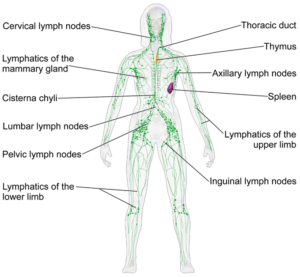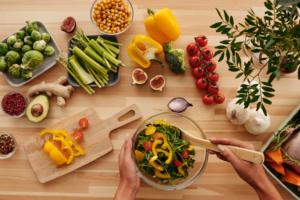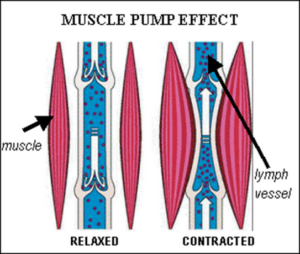The lymphatic system
Function
Known as the “Sewerage System”, it’s responsibilities include:
- Transportation of “lymph” to remove waste products.
- Maintain fluid levels.
- Assists with functioning of the immune system.
Structure
Lymphatic Vessels:
Drains and absorbs fluid from body tissue and transports the fluid (now referred to as “lymph”) through the system.
Lymph Nodes:
Filters that are found primarily in the neck, armpits, abdomen and groin. Heavily concentrated in white blood cells for removing pathogens.
Lymphatic Ducts:
Transports fluid from one section of the body to another.

Conditions and Symptoms
Conditions
- Inflammation – this can be due to any form of physical, emotional or chemical stress to the body.
- Infections
- Cancer removal procedures (i.e. mastectomies’ and lymph node removals)
- Lipedema – chronic disorder to fat metabolism which increases the accumulation of fat.
- Lymphedema – excess accumulation of fluid
Symptoms
- Swelling
- Stiffness
- Mental fatigue – brain fog, depression
- Bloating and increase to weight
- Changes to diet intolerances, digestive issues and constipation.
- Immunity weakness and allergies
- Swollen lymph nodes
- Hormonal imbalances
- Physical fatigue
Why Treat The Lymphatic System:
Reduce swelling and the accumulation of lymph
The previous conditions directly impact the lymphatic system by causing an excess accumulation of fluid and can impact movement in day to day life.
Autoimmune disorders
Lymphatic drainage treatment has been shown to improve the following symptoms in patients with chronic autoimmune disorders:
- Pain and stiffness
- Fatigue, depression and anxiety
- Insomnia ad brain fog
- Headaches and sinus infections
Post Surgical Recovery
Swelling and inflammation are expected following any type of surgical procedure. Treating the lymphatic system can assist with reducing pressure on the affected sites and facilitate a speedy recovery.
Skin Disorders
Treatment is known to improve symptoms of people with acne, psoriasis, eczema, cellulite and spider veins, by encouraging the production of collagen.
Gastrointestinal Purposes
Disruptions to the lymphatic system can slow down your metabolism. By improving the functioning of our parasympathetic nervous system through lymphatic drainage, treatment can assist with constipation and weight loss issues.
What you can do at home?
Exercise
- Keeping your body moving is essential to increasing lymph flow.
The more stagnant you are, the less drainage you will experience - Self pump exercises – you will be given specific pumping exercises
suitable to your condition which can assist
Diet
- Hydration – it is important to stay hydrated to facilitate
drainage and circulation. - Natural anti-inflammatories – green leafy vegetables, fatty
fish and nuts. - Anti-oxidants – vegetables, seafood and vegetable oils.
- Avoid sugar and alcohol – natural inflammatory products
that can hinder your recovery.

Occupational Therapy
Manual Lymphatic Drainage
MLD is a technique to facilitate lymphatic drainage from the body and can be done so through hands on treatment or through other means such as taping.
70% of the vessels are in the outermost layer of the screen, requiring pressure for MLD to be very soft. This allows for a more controlled method of transporting lymph.
It may take 6-8 weeks for the lymphatic system to be running efficiently again, MLD focuses more on improving the capabilities of the system and less on “pushing out the swelling”.
Your occupational therapist will also recommend motions or actions that can assist with self-drainage, to assist the hands-on treatment and manage your symptoms.
Physiotherapy
Exercise and Movement
Unlike your vascular system where your heart can act as a pump for transporting blood throughout your body, your lymphatic system does not have this assistance.
Instead, it relies heavily on muscle movement and increased blood pressure to maintain its functional capacity.
It is recommended that you maintain exercise where possible, to increase blood flow and keep your muscles activated. A minimum of 20minutes per day of exercise will not only assist with this functioning but is also recommended to improve muscular and cardiovascular health.
Our Physiotherapists can assist with increasing blood flow and movement through appropriate exercises to assist with lymphatic drainage.

Chiropractic
Adjustments
How does chiropractic care assist the lymphatic system:
- Cellular level changes – adjustments are known to increase the movement of fluid in our body by improving the rate of collection, release and circulation of lymph.
- Postural imbalances – poor posture, stress and ergonomics can cause curvatures to the spine and strain the internal systems of our body.
- Support for a healthy immune system.
- Proper functioning and movement of our muscles and joints – our body is controlled by our nervous system. Chiropractic adjustments aim to directly improve the way our nervous system is functioning.

Plan Recommendations for Manual Lymphatic Drainage
Your recommended 12 session plan:
- 3 sessions per week for 4 weeks
- 2 Sessions per week for 6 weeks
- 1 session per week for 12 weeks
Reviews to be completed at the end of each plan – posture photo, biometric analysis and other relevant tests.

Download PDF here [Lymphatic Drainage Recommendation]
Learn more about Lymphatic Drainage.
Related Posts
Explaining the Enteric Nervous System
2 May 2017
This article focuses on the role of the enteric nervous system (ENS) for overall health. The ENS is a system of cerebral nervous tissue which is in structure and function very similar to the brain. This is why the ENS is called the ‘The second brain’.
0 Comments5 Minutes
I Tried Physiotherapy…
20 June 2016
Every health practitioner has heard the similar form of complaint, where a patient reports having tried treatment X or Y from discipline A or B but had gotten no results. In some rare occasions a patient may be mismanaged by their previous practitioner, however this is very unlikely.
0 Comments7 Minutes


